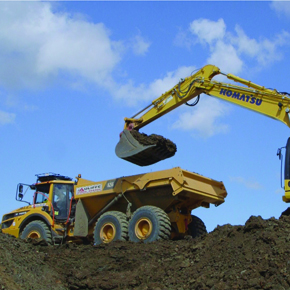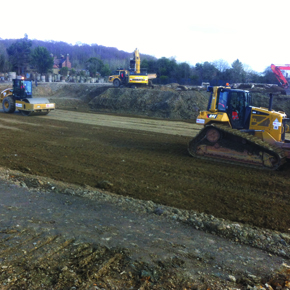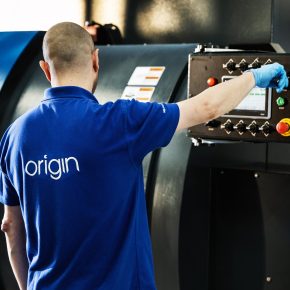
Facing the challenges of brownfield sites
McAuliffe discusses how brownfield land offers UK housebuilders proximity to urban amenities and the opportunity to avoid using greenfield sites. Planning reforms in 2015 have lifted red tape within the planning application process, improving the efficiency of gaining approval to build on brownfield sites…
A core concern when preparing brownfield land for re-development is the assessment and treatment of contaminants. Housebuilders should approach a remediation specialist from the outset, as early involvement ensures that time efficiencies and financial savings are made.
 Understanding the end use of land and associated risks allows a specialist to formulate a tailor-made approach, avoiding unnecessary processes which may incur additional costs with no supplementary benefits.
Understanding the end use of land and associated risks allows a specialist to formulate a tailor-made approach, avoiding unnecessary processes which may incur additional costs with no supplementary benefits.
Remediation of brownfield land for the purpose of residential development demands a more comprehensive strategy than if the land is destined for industrial use. For housebuilders, planning laws dictate that the land is formally assessed in accordance with model procedures for the management of land contamination (CLR 11).
This states that a three-stage approach is required for a comprehensive site evaluation; a desk study, site characterisation and risk assessment. The desk study is a relatively quick and inexpensive way of determining a site’s industrial past, whereas the site characterisation involves a more in-depth study of the site and ground conditions.
Risk assessment is the third vital component, where the team determines the level of clean-up required based on the contaminants present.
Significant and dangerous issues can arise if a remediation strategy isn’t comprehensive. McAuliffe is aware of one such incident where an initial site investigation identified a hazardous contaminant in the ground, which required a separate compound being injected in order to treat it.
 Unfortunately, the initial investigation wasn’t thorough enough and failed to detect a secondary contaminant. The compound injected to neutralise the first contaminant caused the second one to mobilise, creating a serious pollution event which could have been avoided if the initial investigation was more comprehensive.
Unfortunately, the initial investigation wasn’t thorough enough and failed to detect a secondary contaminant. The compound injected to neutralise the first contaminant caused the second one to mobilise, creating a serious pollution event which could have been avoided if the initial investigation was more comprehensive.
This kind of incident can cause huge issues for residential developers, as time and money must be set aside to deal with the pollutants.
With potentially hazardous construction materials being transported and disposed of in high volumes, it is important that firms take responsibility for their environmental impact.
McAuliffe adheres to the European waste hierarchy, a five-step plan included in article four of the waste framework directive. Following the key stages of prevention, reuse, recycle, recovery and disposal ensures that the maximum amount of material is recycled, keeping costs down and minimising negative environmental impact.
On a recent project at Prescot Business Park, the following savings were achieved:
- 100,000 tonnes of concrete were crushed and screened to produce recycled material
- Tree roots and timber were cleaned and shredded, resulting in approximately 200 tonnes of material sent off to biomass
- 500 tonnes of carbon savings were made
- Approximately 50 tonnes of polyethylene gas and water pipes were removed from the site for recycling
In an industry where the smallest efficiencies can translate to huge savings, it is important to invest in the latest technologies. 3D GPS instrumentation was installed in the team’s fleet of dozers and excavators on a recent quarry project in Doseley, Telford.
This allowed efficient access to data, enabling the team to monitor test locations and stay fully informed on the progress of each stage. The additional data increased confidence in the remediation process and geotechnical improvement, making securing NHBC and other regulatory approval much more straight-forward.
The use of this technology benefited the housebuilder because it allowed far greater flexibility over house positions as the entire site was rendered suitable for shallow strip foundation.
Piling was not required – a massive gain for residential developers who needed to be able to re-plan sites during the development phase. Employing a team with this kind of technological experience and keenness to invest in the latest software is another advantage of involving a remediation specialist at an early stage.
With key efficiencies made, housebuilders are able to avoid pitfalls while keeping to tight budgets and meeting construction deadlines.
Find out more in the March issue of ABC+D Magazine
Latest news

21st November 2024
Altro distils style and performance at English Spirit
English Spirit Distillery has used an extensive package of Altro products front and back of house, in their new visitor centre café, shop and viewing area for the working distillery.
Posted in Articles, Bathrooms, Bedrooms & Washrooms, Building Industry News, Building Products & Structures, Building Systems, Case Studies, Floors, Interior Design & Construction, Interiors, Kitchens, Restoration & Refurbishment, Retrofit & Renovation, Timber Buildings and Timber Products, Walls
21st November 2024
Abloy UK creates bespoke locking solution for Secure Information Boxes
Abloy UK has supplied The Safety Letterbox Company Ltd with a bespoke Sentry CL811 Camlock for use in its Secure Information Boxes, assisting life safety and complying with new regulations and legislation for high rise buildings.
Posted in Access Control & Door Entry Systems, Architectural Ironmongery, Articles, Building Industry News, Building Products & Structures, Building Regulations & Accreditations, Building Services, Case Studies, Facility Management & Building Services, Health & Safety, Posts, Restoration & Refurbishment, Retrofit & Renovation, Security and Fire Protection
20th November 2024
CUPA: CUPACLAD enhances hotel aesthetics with a creative natural slate façade
Situated at the northern edge of a newly developed retail park near Bristol, the Abbey Wood Travelodge was conceived as part of the company’s new Budget-Luxe line of hotels – it features CUPACLAD, from CUPA PIZARRAS.
Posted in Articles, Building Industry News, Building Products & Structures, Building Systems, Case Studies, Cladding, Concrete, Cement, Admixtures, Facades, Posts, Restoration & Refurbishment, Retrofit & Renovation, Walls
20th November 2024
Origin launches in-house powder coating facility
Origin’s latest investment is set to redefine industry standards as it launches its own in-house powder coating facility.
Posted in Aluminium Products, Articles, Building Industry News, Building Products & Structures, Building Systems, Doors, Glass, Glazing, Innovations & New Products, Paints, Coatings & Finishes, Restoration & Refurbishment, Retrofit & Renovation, Site Preparation, Windows
 Sign up:
Sign up: